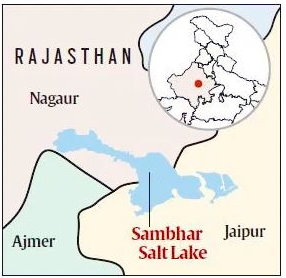Avian Botulism in Rajasthan | 18 Nov 2024
Why in News?
Recently, the Centre for Avian Research Institute reported the death of at least 600 migratory birds in Rajasthan.
- High temperatures and reduced salinity in Sambhar Lake likely created conditions that triggered Avian Botulism, causing the mass deaths of migratory birds.
Key Points
- About Avian botulism:
- It is a neuro-muscular illness caused by Botulinum (natural toxin) that is produced by a bacteria Clostridium botulinum.
- The bacteria is commonly found in the soil, rivers, and seawater. It affects both humans and animals.
- It also needs anaerobic (absence of oxygen) conditions and does not grow in acidic conditions.
- It affects the nervous system of birds, leading to paralysis in their legs and wings.
- Bacterial spores are widespread in wetland sediments and are commonly found in wetland habitats.
- They are present in invertebrates like insects, mollusks, crustaceans, and even healthy vertebrates, including birds.
- The outbreaks of avian botulism tend to occur when average temperatures are above 21 degrees celsius, and during droughts.
- The deaths began on 26th October 2024, and continued for approximately two weeks.
- It is a neuro-muscular illness caused by Botulinum (natural toxin) that is produced by a bacteria Clostridium botulinum.
- Contributing Environmental Factors:
- Jaipur district, 70 km from Sambhar Lake, recorded above-average temperatures throughout October.
- Sambhar Lake experienced reduced oxygen levels due to the absence of rainfall.
- Vulnerability of Migratory Birds
- Migratory birds arrive weakened from long journeys, making them more susceptible to diseases.
- Decaying bird carcasses attract maggots, which further contaminate the water and infect other birds or animals.
- Management and Challenges
- Avian botulism cannot be treated, but immediate removal and disposal of affected birds are recommended to limit the spread.
- Sambhar Lake experienced a similar die-off in 2019, resulting in the deaths of nearly 18,000 birds.
- Outbreaks are hard to predict as they depend on specific environmental conditions aligning, such as a shift from high to low salinity coinciding with the arrival of migratory birds.
- Global Perspective
- Spores of Clostridium botulinum can survive for years but produce toxins only under favorable environmental conditions.
- Similar outbreaks have been observed in Australia and the United States during periods of reduced salinity.
- Globally, around 57 diseases have been reported among wild birds, highlighting the broader ecological risks.
Sambhar Lake
- Location:
- Situated about 80 km southwest of Jaipur, in east-central Rajasthan.
- Features:
- It is the largest inland salt lake in India. It represents the depression of the Aravalli Range.
- The lake’s salt supply was worked by the Mughal dynasty (1526–1857) and it was later owned jointly by the Jaipur and Jodhpur princely states.
- Ramsar Site:
- It is a wetland of ‘international importance’ under the Ramsar Convention, declared in 1990.
- Rivers:
- It receives water from six rivers, namely Samaod, Khari, Mantha, Khandela, Medtha, and Roopangarh.
- Vegetation:
- The vegetation present in the catchment area is mostly xerophytic type.
- Xerophyte is a plant adapted for growth under dry conditions.
The Central Avian Research Institute of India (CARI)
- It is a research institute located at Izzatnagar near Bareilly, Uttar Pradesh.
- It was established in 1979 under the administrative control of Indian Council of Agricultural Research (ICAR).
- It studies poultry science, including avian genetics, breeding, nutrition and feed technology, and avian physiology and reproduction, for the betterment of the Indian poultry industry.

